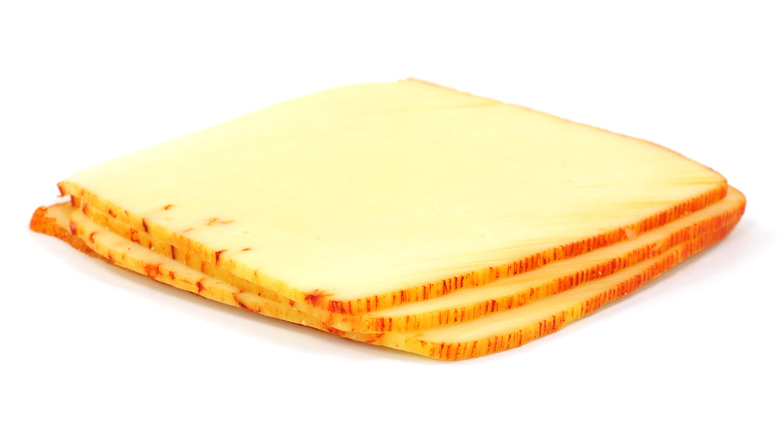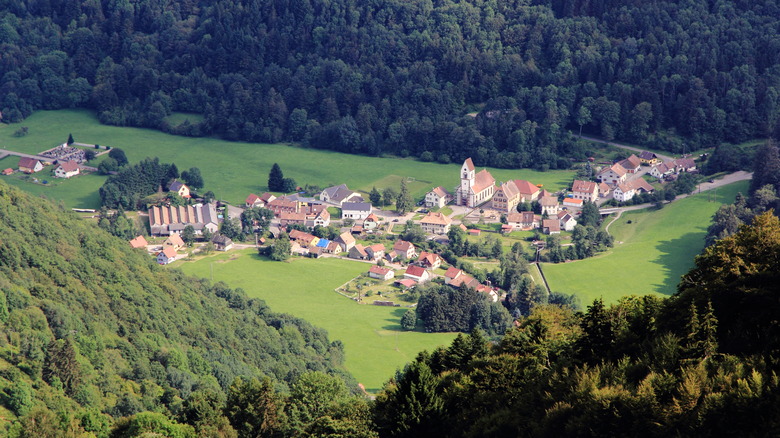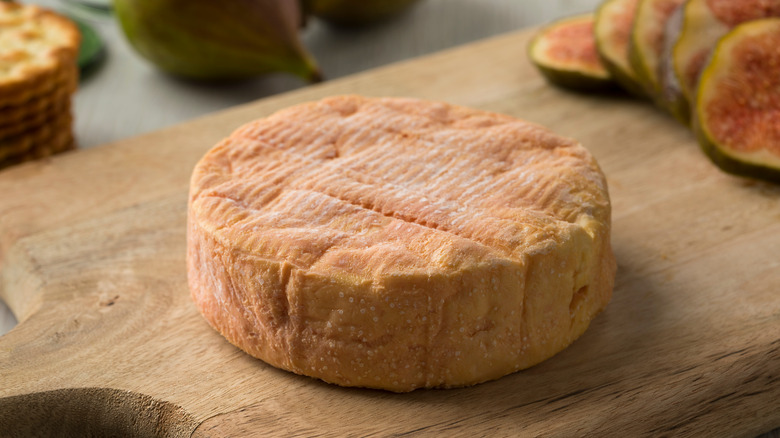Muenster Cheese Actually Originated In Ancient France
Muenster cheese is one of the myriad cheeses from around the world everyone ought to try at least once. It's a classic of the dairy world, dating back to ancient France. Aside from historical roots, though, what makes this food so special?
It's a rather distinctive-looking, smelling, and tasting cheese. According to the Encyclopedia Britannica, on the outside, Muenster is dyed orange, while on the inside, it's a creamy golden color. Wisconsin Cheese, however, notes that European Muensters are often paler than elsewhere. Typically, the cheese is disk-shaped, 2 inches thick, and 8 inches in diameter. The elastic, rich, semisoft interior often oozes but doesn't run. Once ripe, Muenster produces a strong, earthy smell. Although the cheese is milder when young, age and cumin give it a sharper, nuttier flavor over time. Cheese.com describes Muenster as savory and tangy, as well.
While it can certainly be enjoyed on its own, Muenster is frequently paired with beers such as lagers, pale ales, and stouts, as well as wines like chardonnay and pinot noir. Folks often slice up Muenster (easiest with firm, chilled disks and damp, oiled knives, per Las Terceras) for use on burgers and sandwiches, or they melt it for dishes such as grilled cheese, macaroni, pizza, quesadillas, and scrambles. It can be added to desserts, salads, and potato-based meals (via the Office of Tourism of the Valley of Munster). When storing Muenster, separate slices with wax paper to prevent them from sticking.
How did this all get started, though?
Munster monastery
As mentioned, Muenster is time-honored and French in origin. Both Encyclopedia Britannica and Wisconsin Cheese point to an ancient monastery in Alsace, France as the creator of this food, but Alsace is a whole region. For specifics, one must look to Alsace's Munster Valley, particularly during the A.D. 600s (via the Office of Tourism of the Valley of Munster). The Interprofessional Syndicate of Munster Cheese explains that the 7th century was when monks first arrived in the area's Vosges mountains to spread their religion, bringing knowledge of cheese production with them. Cows there could easily graze on the mountains' greenery, providing the monks with plenty of milk. So, Muenster cheese was developed to store dairy, presumably because the firm rind kept the softer inside well protected for a longer time. This also made it easier for monks to feed the numerous local inhabitants, likely garnering goodwill for their faith in the process.
One might think that "Muenster" gets its name from "Munster Valley." In a way, they would be right (and "Munster" still persists as an alternative spelling of "Muenster"). Yet, "Munster" is apparently derived from the word "monastery." Thus, Muenster cheese could just as easily be called Monastery cheese! It's come a long way since those days, however.
Modern Muenster
Fast forward more than a millennium and Muenster is made not just in France, but globally in regions like the United States, Scandinavia, and Germany, as well, per Britannica. In 1969, Muenster earned a protected designation of origin back in its home country, per the Office of Tourism of the Valley of Munster. Thus, the fatty cheese is still made via traditional means in and around Munster, according to the Interprofessional Syndicate of Munster Cheese. In summer and fall, cows graze on the mountains' tall vegetation in full force (via Cheese.com). After crude milk is produced, local farmers mix it, heat it in big copper cauldrons, and separate it. Leftover curds are molded, turned, salted, and then matured — hand-rubbed for weeks on end to form the washed rind. Finally, from May to October, Muenster cheese comes into season.
Fairly recently, in 1987, the Cheese Tasting Guild was founded in France to unite Muenster fans, with members wearing robes in the style of Munster abbey monks. Yet, authentic Muenster may be in trouble. As recently as 2018, The Local reported that boars were running amok across Munster's countryside, sullying the pastures where cows graze and threatening Muenster production. France Bleu documented how farmers asked hunters to fend off these wild menaces, so hopefully Muenster isn't going anywhere any time soon. After all, it would be a shame to lose such a valuable edible relic.


